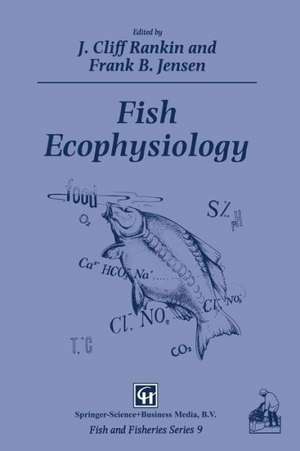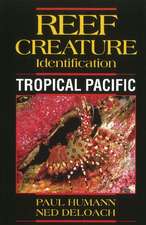Fish Ecophysiology: Fish & Fisheries Series, cartea 9
Autor J.C. Rankin, Frank B. Jensenen Limba Engleză Paperback – 3 oct 2013
Din seria Fish & Fisheries Series
- 18%
 Preț: 1116.09 lei
Preț: 1116.09 lei - 18%
 Preț: 978.12 lei
Preț: 978.12 lei - 18%
 Preț: 1242.66 lei
Preț: 1242.66 lei - 18%
 Preț: 1223.74 lei
Preț: 1223.74 lei - 18%
 Preț: 1224.85 lei
Preț: 1224.85 lei - 18%
 Preț: 942.76 lei
Preț: 942.76 lei - 18%
 Preț: 1233.06 lei
Preț: 1233.06 lei - 15%
 Preț: 647.40 lei
Preț: 647.40 lei - 18%
 Preț: 2490.41 lei
Preț: 2490.41 lei - 18%
 Preț: 1239.19 lei
Preț: 1239.19 lei - 24%
 Preț: 1301.39 lei
Preț: 1301.39 lei - 18%
 Preț: 2099.91 lei
Preț: 2099.91 lei - 15%
 Preț: 650.19 lei
Preț: 650.19 lei - 18%
 Preț: 1837.88 lei
Preț: 1837.88 lei - 18%
 Preț: 1227.21 lei
Preț: 1227.21 lei - 18%
 Preț: 1230.84 lei
Preț: 1230.84 lei - 18%
 Preț: 947.35 lei
Preț: 947.35 lei - 18%
 Preț: 961.86 lei
Preț: 961.86 lei - 18%
 Preț: 1234.00 lei
Preț: 1234.00 lei - 18%
 Preț: 1226.11 lei
Preț: 1226.11 lei - 18%
 Preț: 1224.99 lei
Preț: 1224.99 lei - 18%
 Preț: 1234.00 lei
Preț: 1234.00 lei - 18%
 Preț: 1234.62 lei
Preț: 1234.62 lei - 15%
 Preț: 716.15 lei
Preț: 716.15 lei - 18%
 Preț: 1236.19 lei
Preț: 1236.19 lei - 18%
 Preț: 975.73 lei
Preț: 975.73 lei - 18%
 Preț: 1229.91 lei
Preț: 1229.91 lei - 18%
 Preț: 2494.20 lei
Preț: 2494.20 lei - 18%
 Preț: 995.34 lei
Preț: 995.34 lei - 18%
 Preț: 1233.20 lei
Preț: 1233.20 lei - 18%
 Preț: 1230.66 lei
Preț: 1230.66 lei
Preț: 647.73 lei
Preț vechi: 762.04 lei
-15% Nou
Puncte Express: 972
Preț estimativ în valută:
123.96€ • 128.06$ • 103.17£
123.96€ • 128.06$ • 103.17£
Carte tipărită la comandă
Livrare economică 25 martie-08 aprilie
Preluare comenzi: 021 569.72.76
Specificații
ISBN-13: 9789401050173
ISBN-10: 9401050171
Pagini: 444
Ilustrații: XX, 421 p. 29 illus.
Dimensiuni: 155 x 235 x 23 mm
Greutate: 0.62 kg
Ediția:1993
Editura: SPRINGER NETHERLANDS
Colecția Springer
Seria Fish & Fisheries Series
Locul publicării:Dordrecht, Netherlands
ISBN-10: 9401050171
Pagini: 444
Ilustrații: XX, 421 p. 29 illus.
Dimensiuni: 155 x 235 x 23 mm
Greutate: 0.62 kg
Ediția:1993
Editura: SPRINGER NETHERLANDS
Colecția Springer
Seria Fish & Fisheries Series
Locul publicării:Dordrecht, Netherlands
Public țintă
ResearchCuprins
1 Bioenergetics: feed intake and energy partitioning.- 1.1 Introduction.- 1.2 Basic principles.- 1.3 Factors influencing ingestion (R).- 1.4 Factors influencing faecal losses (F).- 1.5 Products of nitrogenous excretion (U).- 1.6 Factors influencing metabolism (M).- 1.7 Factors affecting growth and production (P).- 1.8 Concluding remarks.- References.- 2 Biochemical correlates of growth rate in fish.- 2.1 Introduction.- 2.2 Protein synthesis and growth.- 2.3 Perturbations in the general model.- 2.4 Protein synthesis and energy consumption.- 2.5 Free amino acids and protein turnover.- 2.6 Growth and its correlates in the tissues.- 2.7 Biochemical indices of growth rate.- 2.8 Linkage between aerobic enzymes and RNA.- 2.9 Body size effects on protein growth. synthesis and RNA concentrations.- 2.10 Temperature.- 2.11 Estimation of growth rate of fish in the North Sea.- Acknowledgements.- References.- 3 Growth, reproduction and death in lampreys and eels.- 3.1 General introduction.- 3.2 Lampreys.- 3.3 Eels.- 3.4 General discussion.- Acknowledgements.- References.- 4 Salmonid smolting: a pre-adaptation to the oceanic environment.- 4.1 Introduction.- 4.2 Changes during parr-smolt transformation.- 4.3 Role of environmental factors.- 4.4 Conclusion.- Acknowledgements.- References.- 5 Role of peptide hormones in fish osmoregulation.- 5.1 Introduction.- 5.2 Growth hormone (GH).- 5.3 Angiotensin II (ANGII).- 5.4 Arginine vasotocin (A VT).- 5.5 Urotensins (UI and UII).- 5.6 Vasoactive intestinal peptide (VIP).- 5.7 Natriuretic peptides.- Acknowledgements.- References.- 6 Environmental perturbations of oxygen transport in teleost fishes: causes, consequences and compensations.- 6.1 Introduction.- 6.2 Hypoxia.- 6.3 Combined hypoxia-hypercapnia.- 6.4 Temperature.- 6.5 Salinity change.- 6.6 Effects of toxicants.- 6.7 Concluding remarks.- Acknowledgements.- References.- 7 Cardiovascular and ventilatory control during hypoxia.- 7.1 Introduction.- 7.2 Chemoreceptors.- 7.3 Mechanoreceptors.- 7.4 Catecholamine release.- 7.5 Methods of studying ventilation in water-breathing animals.- 7.6 Ventilatory responses to hypoxia.- 7.7 Circulatory responses to hypoxia.- 7.8 General conclusions.- Acknowledgements.- References.- 8 Acid-base regulation in response to changes of the environment:characteristics and capacity.- 8.1 Introduction.- 8.2 Environmentally induced changes of the acid-base status.- 8.3 Characteristics of regulatory responses.- 8.4 Capacity of acid-base relevant ion-transfer mechanisms as a function of environmental conditions.- 8.5 Conclusion.- References.- 9 Environmental effects on fish gill structure and function.- 9.1 Introduction.- 9.2 Environmental ions.- 9.3 Morphological component to acid-base regulation.- 9.4 Environmental pH and oxygen.- Acknowledgements.- References.- 10 Effects of water pH on gas and ion transfer across fish gills.- 10.1 Introduction.- 10.2 Proton excretion.- 10.3 Effect of water pH on proton transport.- 10.4 Interactions between proton, carbon dioxide and ammonia excretion.- 10.5 Sodium uptake.- 10.6 Chloride uptake.- 10.7 Carbon dioxide transfer.- 10.8 Oxygen transfer.- 10.9 Ammonia excretion.- 10.10 Swimming performance.- References.- 11 Endocrine responses to environmental pollutants.- 11.1 Introduction.- 11.2 Adrenocortical response.- 11.3 Adrenergic responses.- 11.4 Prolactin.- 11.5 Thyroid response.- 11.6 Future studies.- References.- 12 Branchial mechanisms of acclimation to metals in freshwater fish.- 12.1 Introduction.- 12.2 Effects of metals on gill morphology.- 12.3 ‘Shock’ phase.- 12.4 Branchial defences against acute metal toxicity.- 12.5 Recovery and the origin of metal tolerance.- 12.6 Increased tolerance via decreased metal accumulation by the gills.- 12.7 Increased tolerance via increased metal storage and detoxification in gill tissue.- 12.8 Increased tolerance via increased resistance of metal-sensitive processes.- 12.9 Conclusions.- 12.10 Future research directions.- Acknowledgements.- References.- 13 Phenotypic plasticity of fish muscle to temperature change.- 13.1 Introduction.- 13.2 Muscle function and temperature.- 13.3 Temperature acclimation of swimming performance.- 13.4 Plasticity of muscle phenotypes.- 13.5 Muscle contractile properties.- 13.6 Muscle metabolism.- 13.7 Future prospects.- Acknowledgement.- References.- 14 Recent advances in the ecophysiology of Antarctic notothenioid fishes: metabolic capacity and sensory performance.- 14.1 Introduction.- 14.2 Respiration and metabolism.- 14.3 The cardiovascular system.- 14.4 The blood oxygen transport system.- 14.5 Responses to stress.- 14.6 Sensory ecophysiology of notothenioid fishes.- 14.7 Ecophysiology and evolution of notothenioid fishes.- Acknowledgements.- References.- 15 Ecophysiology of intertidal fish.- 15.1 Introduction.- 15.2 The intertidal environment.- 15.3 Temperature.- 15.4 Osmoregulation.- 15.5 Respiratory adaptations.- Acknowledgements.- References.- Author index.




